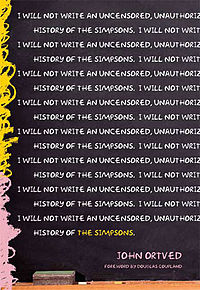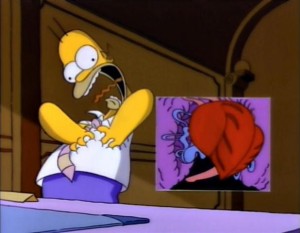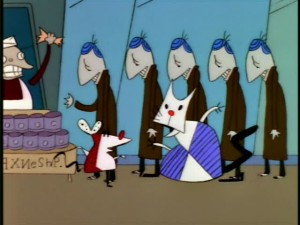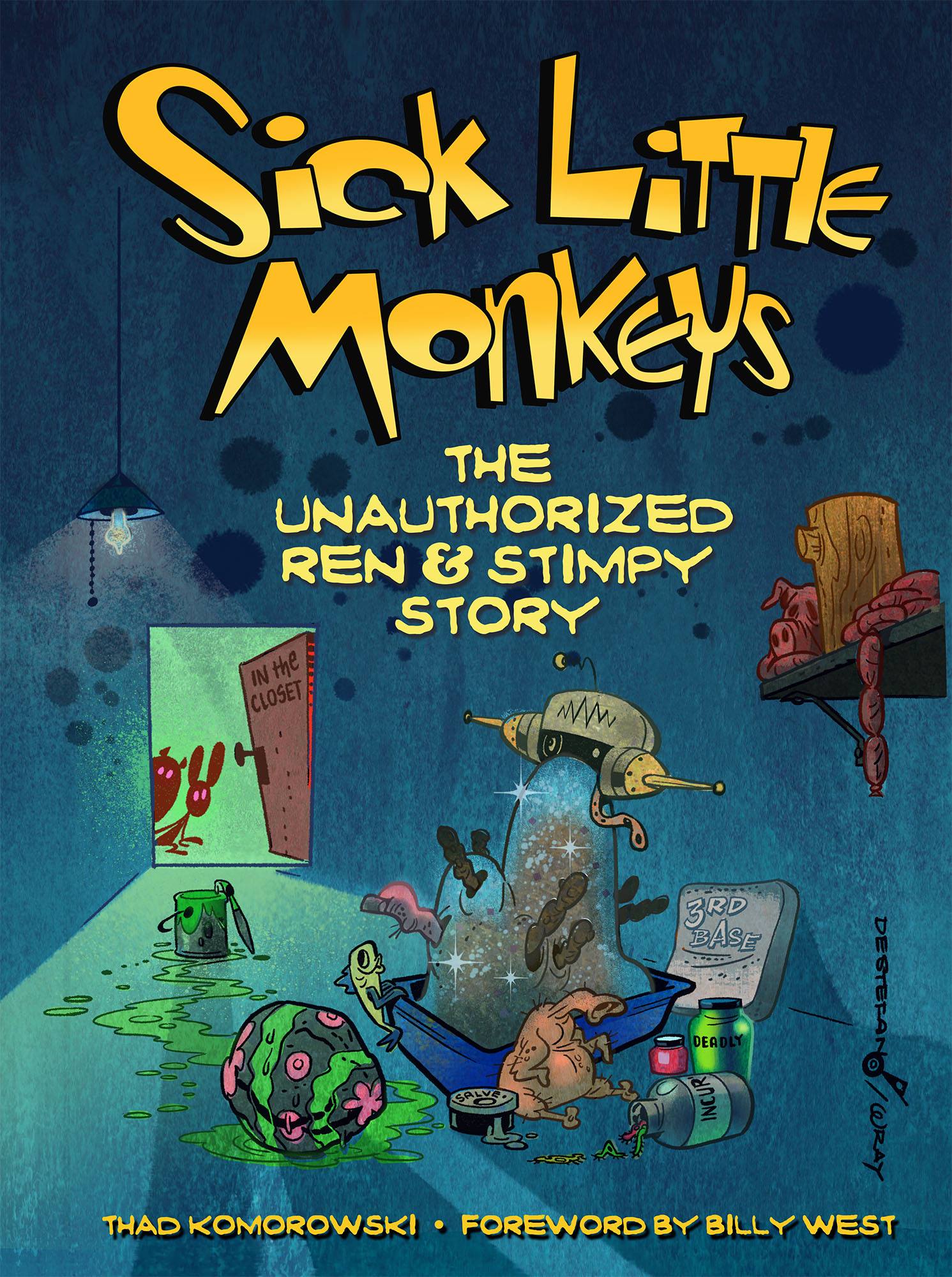(This site may become Thadwell’s Book Corner soon, but don’t count on it.)
 It’s been over two years since the release of John Ortved’s The Simpsons: An Unauthorized, Uncensored History. I put off reading it until very recently. The consensus is that while Ortved did a solid job researching his subject, he botched the presentation.
It’s been over two years since the release of John Ortved’s The Simpsons: An Unauthorized, Uncensored History. I put off reading it until very recently. The consensus is that while Ortved did a solid job researching his subject, he botched the presentation.
The book takes that most undemanding route of the oral history, a format indicative of a writer with zero narrative skill. The adeptness to accumulate the facts was there, as successfully conducting some eighty interviews is no mean feat, but weaving them into something compelling was beyond Ortved.
Ortved’s own prose is fannish at best. The book credits a copyeditor, but one wonders what that job entailed given how ham-fisted the final book is. (There are also many typos and grammatical errors.) Ortved presents his own anecdotes under the delusion that someone reading a history of The Simpsons is interested in his personal viewing experiences. He is also presumptuous thinking that the reader already knows who worked on which episodes; that by merely naming episode titles, his case for what exactly was “the Simpsons‘ Golden Age” is made.
The best example of the book’s shortcomings may be the entire chapter devoted to former Simpsons writer Conan O’Brien (he was one of Ortved’s more prestigious interview subjects, quoted on the back cover). O’Brien was obviously an essential presence in the writers room. Surely his best solo writing job, Marge vs. the Monorail, is one of the few perfect half-hours of 1990s television (and far funnier than anything else he’s done, up to and including the present day). Ortved never tells us why O’Brien was significant to the series. All we learn is that the other writers found him a continuous riot and that they were all amazed to see where he’s gone.
One of the chief complaints is that Ortved is too opinionated in his book. He doesn’t think too highly of the last 15 years or so of The Simpsons, and thus received poor marks for his dismissal. Of course, anyone with eyes shares his opinion of the show’s decline. Rather, the resentment should be towards how poorly he framed his critiques. Ortved’s analysis of the Simpsons‘ peak is practically nonexistent, whereas his emphasis, prose on how “lame” the later episodes are, is barely above the average Internet forum posting.
The block quotes are ultimately what you’re going to get the book for. Now that the book is less than $11 on Amazon, you could do much worse. Certainly the price is justified for people like O’Brien or Brad Bird talking about the show in detail. It’s also a great primer for those interested in learning about the show’s chief architects. The quotes give indication of how compelling a history of The Simpsons could really be.
Journalist [and Simpsons guest voice] Tom Wolfe makes a thought provoking comment near the end of the book. “The Simpsons also managed to make a virtue out of bad draftsmanship. The characters are really terribly drawn, but they are so stylized that it doesn’t make any difference any longer.”
 Truer words were never spoken about the show. Fans like to romanticize about the fist few seasons, but the show was always poorly drawn and mechanically animated. What was wonderful, though, is that it was a deliberate mechanicalness, one that helped emphasize the sharp writing and the best ensemble of voice actors in decades. It was not merely what its detractors call an ink-and-paint live-action show. While owing more to live-action than any cartoon, it was still something that couldn’t work if it was not animated. When the writing was golden, they used cartoon license to add to the scripts’ quirkiness. Surely no one could envision animator David Silverman’s scenes of Homer’s heart attack or “No TV and no beer make Homer something-something” translating nearly as well into a live-action comedy; the movement is humorously stilted, becoming a new form of stylization in the process. This effect deteriorated as the show progressed, no doubt. When the writing went to pot and the voices started phoning in, there was nothing to hide the crude formula of the draftsmanship that was always present.
Truer words were never spoken about the show. Fans like to romanticize about the fist few seasons, but the show was always poorly drawn and mechanically animated. What was wonderful, though, is that it was a deliberate mechanicalness, one that helped emphasize the sharp writing and the best ensemble of voice actors in decades. It was not merely what its detractors call an ink-and-paint live-action show. While owing more to live-action than any cartoon, it was still something that couldn’t work if it was not animated. When the writing was golden, they used cartoon license to add to the scripts’ quirkiness. Surely no one could envision animator David Silverman’s scenes of Homer’s heart attack or “No TV and no beer make Homer something-something” translating nearly as well into a live-action comedy; the movement is humorously stilted, becoming a new form of stylization in the process. This effect deteriorated as the show progressed, no doubt. When the writing went to pot and the voices started phoning in, there was nothing to hide the crude formula of the draftsmanship that was always present.
In the decades since The Simpsons premiered, there have been many primetime animated shows. These shows’ creators included people who would like to be doing live-action exclusively but use drawings as a means of presenting unoriginality as hip (Mike Judge), those whose greatest talent is exploiting the growing ADHD in our society (Seth MacFarlane), and even some who enlarged upon The Simpsons‘ virtues and carried them out in a completely different way (Trey Parker/Matt Stone).
Prime time animation has not been very visually pleasing as a result, and that irks a lot of people. It’s undeniable that having people ingrained in live-action has worked in these shows’ favor. Controversial though it may be, live-action people are just plain smarter than animation people. If it were the other way around, maybe every major artist-driven series or studio wouldn’t fizzle out/peak after a couple of films/years, be it financially or artistically.
Ortved was charged with being one-sided because he didn’t interview Groening or mogul James L. Brooks for his book. Much of this had to do with Ortved’s emphasis on the important role TV writing legend Sam Simon played in shaping the series and assembling its writing team in the first three years of the show.
Less bothersome to some reviewers is the fact that hardly anyone still involved with the show was interviewed (voice artist Hank Azaria being the primary exception), which is typical for any still-living Hollywood product. Should someone want to write the real Pixar story before the studio dries up (monetarily), they will face the same problems of dealing with the corporation’s front office before they can secure interviews with the talent.
 He quotes Groening and Brooks, albeit from a variety of sources, and was criticized that they weren’t able to answer to charges of their own egos in the present day, which seems to be a naive assumption at best. Anyone who honestly holds this against Ortved has obviously never conducted an interview with people in the entertainment business. Case in point: in preparation for my own book on The Ren & Stimpy Show, there were several notable people who refused to be interviewed, some declines more impassioned than others. More than once I was told that the accuracy of my reporting and writing is compromised because I’m a critic of John K.’s works and words. (They’re welcome to still be interviewed as of this posting.)
He quotes Groening and Brooks, albeit from a variety of sources, and was criticized that they weren’t able to answer to charges of their own egos in the present day, which seems to be a naive assumption at best. Anyone who honestly holds this against Ortved has obviously never conducted an interview with people in the entertainment business. Case in point: in preparation for my own book on The Ren & Stimpy Show, there were several notable people who refused to be interviewed, some declines more impassioned than others. More than once I was told that the accuracy of my reporting and writing is compromised because I’m a critic of John K.’s works and words. (They’re welcome to still be interviewed as of this posting.)
I’m sure Ortved was taught the same thing by his teachers in college that I was: there is no such thing as objectivity. Frequent use of “objectivity”, or “respect”, is symbolic of an individual whose aspirations for controlling what others think clouds his or her own reasoning. The best commodities of Hollywood always stem from powerful egos, and it’s only natural that people want to control how the history they lived is presented. Ortved said the big players would be fine talking to him if he would write a puff piece on the making of the Simpsons Movie. Likewise, regardless of my own attitudes and ardor, some people with R&S would have zero interest in contributing to anything more meaningful than the likes of the tame oral history (see the pattern?) that appeared in the most recent issue of Hogan’s Alley. Had Ortved actually interviewed the holdouts, they probably wouldn’t have answered the tough questions anyway.
All of which is to say that I certainly sympathize with Ortved’s plight, but I wish a better written book came out of it. There are endless hints throughout at how fascinating and wonderful a book about what was one of the most important TV shows of all time, and what was inarguably one of the few products of TV animation worth taking seriously, could be. Ortved laid the rough foundation, now it’s up to someone to utilize it. Maybe the show will actually be over by then.


Very interesting review. This seems to be one end of the spectrum for books like these. The other end would be Planet Simpson by Chris Turner, a book full of philosophical pretension meant to make the author look smart.
I can’t wait to see your Ren & Stimpy book. Such a shame that you have holdouts. Hollywood is a dangerous beast to tangle with. How do you think animation people can smarten up?
To be fair, I think there those that decline interviews are also wary of possible hatchet jobs that go out of their way to put the people involved or the work in an extremely bad light. Of course there are egotists out there, but there is also an element of caution in getting involved in a tabloid-style book.
I know Beavis and Butthead are based off the Katzenjammer Kids and King of the Hill is like the Simpsons, but I think what Mike Judge did with these characters is original.
The phrase “anyone with eyes” made my day–and it’s only 7 AM here!
I have a different perspective regarding the animation on the Simpsons than you do, Thad. Despite the low budget of the show, the drawing, posing and animation could’ve been far stronger. The reason they were so weak and rigid is because of choices made by the writers and producers, who were largely ignorant of the artistic side of the craft they chose to work in.
I disagree with Tom Wolfe, too. The Simpsons never made a virtue out of crude draftsmanship and animation; rather it succeeded in spite of it. There were plenty of times when better animation, or at least stronger posing, would have helped sell a joke (or at least matched the broad voice acting). The few episodes with funny animation (usually by Brad Bird, David Silverman, Greg Vanzo, or Wes Archer) bring this point home. Krusty’s heart attack in Krusty Gets Busted is funny, as is Homer’s in the still provided by Thad. Itchy and Scratchy as 1940s cartoon characters defeating Hitler was another great example of what might have been.
Also, live action people aren’t smarter than animators. There are plenty of insipid sitcoms past and present to disprove that notion. In fact, there were several failed animated series either created or overseen by former Simpsons writers — The Critic, Mission Hills, The Oblongs, etc. The dull animation wasn’t a virtue for those shows. (And let’s not forget the poor job former Simpsons writers did with those new Looney Tunes shorts from around 2002.)
There are different kinds of cartoons just as there are different kinds of movies and music. If every piece of animation ever done tried to be broad, there would be nothing special about the animation that actually does broadness well. When I see anything that resembles articulate movement on the show (scenes in Some Enchanted Evening), it’s distracting. The examples you cite, save the Hitler scene (the good animation was the joke), are all awfully drawn and animated. That is definitely success in spite of shoddy work.
Just as there are unwise animation people, there are stupid live-action people, hence the awful product you describe. (Matt Groening was raving over having to do the crossover episode with The Critic – quite understandable if you’ve seen any episodes of that show.) My point is that I have seen far more animated shows with live-action roots succeed, regardless of my opinion of their merit, than those driven by “artists” (the most misused label of all time). The sole exception may be SpongeBob Squarepants, the show Nickelodeon always wanted Ren & Stimpy to be.
The word I used was strong, not broad; that is animation that would be drawn clearly articulating an idea, rather than the dull poses and expressions that aren’t specific enough. The Simpsons doesn’t need to be “cartoony” in order to have better posing and acting. (The original Tracey Ullman show shorts had funny and expressive animation that was far removed from a Warner cartoon, for example.)
Remember, the dull animation and “on model” posing and expressions are the result of the unimaginative tastes of Groening, Brooks and the writing staff. They actually believe the animation in The Simpsons in “subtle”, and akin to live action. They don’t seem to realize that without a strong pose for contrast there can be no subtly. When everything is subtle, then nothing is. (Jones and Clampett used more subtle posing and animation in their wild cartoons than The Simpsons ever has. ) Of course this is only the tip of the iceberg with the problems of the animation in the show. Almost every character has the same posture, the same stock walk cycle, mouth shapes (that don’t usually correspond to the voice acting), ad infinitum.
The articulated movement is distracting in The Simpsons simply because the few times it is used contrasts too sharply with the mostly bland animation — which audiences have grown use to and associate as the “style” of The Simpsons. The drawings by Silverman in Homer’s Triple Bypass are not crude. They are refined drawings of a crudely designed character. That scene contains all the elements of good animation — strong path of action, exaggeration, solid construction of the character, etc.
Sorry to derail the comments section. Back on topic, I most likely won’t buy this book. I lost interest in the show after the 5th season. Maybe I might check it out at the library.
I’ll have to agree with Thad, whatever the intentions of the shows creators, the crude animation effectively pushes the wit of the writing of the show, makes it the focal point of it, actually. We must remember that the design of the show comes from Groening’s cartooning, (Life in Hell). The stationary figure, vacuous expressions, lack of all dynamism, and stupidly simple design is all Groening, is what shapes and accents his humor, as is evident in his strips. The odd screwball extreme is rather the exception to Groening’s style. Now when I see the production further embellished with shadows and wild pans and effects I feel this crude aesthetic strength is forgotten, and the embellishments idiotic.
“[T]he crude animation effectively pushes the wit of the writing…”
Sorry, that makes no sense. The poor animation doesn’t get in the way of the mostly verbal humor of the show, but it doesn’t “plus” or push the humor. There were plenty of times where the animation acting should have been stronger in order to sell a joke, but failed to. During scenes with exaggerated or broad voice acting, the animation and expressions have been too soft to compliment it.
Also, only the Ullman shorts represent the way Matt Groening drew the Simpsons. Those original designs were refined by David Silverman and Wes Archer over the first few seasons of the series. Only Principal Skinner still looks the way Groening originally drew him.
I don’t deny the changes in design, but I continue to see sympathies with the approach taken on the show as it relates to the character of Groening’s old strip work, qualities I enumerated above. Good animation may not “get in the way” of dialogue and jokes, but ‘bad’ animation certainly gives them a specific flavor, and a flavor closer to the reductive nature of Groenings cartooning, which is provisional at best. What was the duration of the Ullman spots, 4 seconds or something?
The shorts from the Ullman era was the peak of The Simpsons in terms of animation.
And it’s no real mystery why other Simpsons producers failed at their other shows; They lacked a strong supporting cast. The magic of The Simpsons comes from the supporting cast which is why seasons 7 &8 work so damn well. There was also a clear distinction between a character and just one dimensional stereotype used for a gag. Ned Flanders, Seymour Skinner, and Moe are characters as opposed to Bumblebee Man, Sea Captain, and Dr. Nick. The Critic, Oblongs, Mission Hill, etc. only had stereotypes for a supporting cast but out of all of them I think Duke Phillips worked the best because he was perfect comic foil for Jay Sherman; He wasn’t just the angry boss, he was the epitome of Jay’s frustrations about society’s ignorance of culture.
Something I forgot to mention, which you touched upon — the reasons for the success or failure of certain animated shows. I have a theory (based on my own bias) that a successful animated show needs to be created by a cartoonist (even if they draw crudely). Matt Groening, Steve Hillenburg, Mike Judge, John K, Seth MacFarlane, Craig McCracken, and Gendy Tartakovsky all fall under this catagory. Most of the animated failures were created by writers — Matthew Carlson, Al Jean & Mike Reiss, and Bill Oakley & Josh Weinstein, for example.
Of course, that leaves out South Park, since the creators aren’t cartoonists (nor professional writers yet, either). Yet there show is based on the animated short they made, and from what I’ve read, they animated paper cut-outs themselves. One other exception is The Oblongs, which was based on a cartoonist’s (very crude) drawings — Angus Oblong.
Angus Oblong’s dark, off beat sense of humor was not the least bit represented on the show. He made the huge mistake of selling the show to the WB, which just wanted a Simpsons clone, instead of Fox which would have been far more open to his ideas. Some of Angus’s story ideas had either Biff or Chip developing a masturbation habit and Beth accidentally swallowing a seed and a tree would grow from her hair. I will say this though, I think Bob Oblong was a great character that brought a lot to show.
Since there’s no edit button here, I wanted to reply to my own comment to clarify what I wrote about the South Park creators. I meant that they weren’t professional writers, in addition to not being cartoonists, at the time they created their animated short The Spirit of Christmas. They’ve obviously since become professional TV and film writers since then.
Read this book for late last year , I think its good for a rough idea of what went on behind the scenes,but as already mentioned, spent too much time on some people like Conan and too little time on someone like John Swartzwelder who wrote the most Simpson episodes.This is what Al Jean (current showrunner) thought about it,taken from the NoHomers message board in 2009.
“Without getting into all the details, I would just like to reiterate that as someone who has been here 20 years, and excepting myself to be fair, I think the book is an extremely distorted view of what went on, and very unfair to some great creative people. I’m sure there will be a true history of the simpsons, and I’m sure I won’t like everything in it, but this ain’t it. Honestly, the Simpsons wikipedia entry is more informative.
Thanks again,
Al
(PS The Annie award “24 Minutes” won was for outstanding WRITING in an animated series, not for the animation (which I did think was excellent). I can be a Jeff Albertson too.)”
“Honestly, the Simpsons wikipedia entry is more informative.”
BURN !
Spot on review of the book. It really is quite poorly written in places, with unnecessary references to Ancient Greece and Roland Barthes that serve no purpose other than to make Ortved appear intelligent. He justifies the oral history form in the preface, claiming that it works as a series of “eye witness” accounts and that attempting to analysis comedy is futile, but as you say, it more displays a lack of ability on the author’s part.
It is still worth reading though. The discussion on The Simpsons animation style reminded me that I still want to see the complete unaired version of ‘Some Enchanted Evening’ that Kent Butterworth directed. Copies do exist, I’ve read stories of how its been bootleged by Klasky Csupo employees and it being shown at parties held by the animation staff. On the season one DVD they only included a few scenes from it, presumably out of embarrassment (same reason why only one Ullman short is on the disc). It’s a fascinating mess. Butterworth was clearly trying to make the animation lively, but its ill suited to the character designs and the overseas studio did a botched job anyway. There were extra visual jokes that weren’t in the script which infuriated Brooks. It was the most heavily reworked episode of the season, pushing the series debut back to the Christmas special, but they did a lot of retakes anyway even with David Silverman and Wes Archer’s episodes, whose directing styles were more in tune with what the producers wanted.
Incidentally Thad have you ever seen ‘Hound Town’? It’s an animated sitcom pilot made by Bakshi productions, notable only for predating The Simpsons by a few months. Its absolutely terrible, Bakshi himself disowned it. Weirdly a number of future Simpsons staff worked on it, including Rough Draft owners Gregg Vanzo and Rich Moore. The whole thing is on YouTube as a poor quality VCR recorded upload.